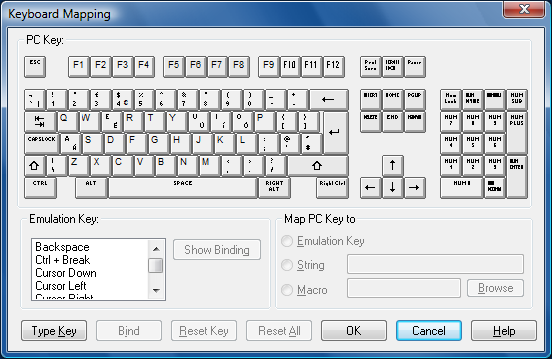Configuring the Keyboard
HostAccess supports many terminal emulations which means that many sets of function keys and special editing keys are available. Each emulation may have a different set of pre-defined emulation keys.
HostAccess has been programmed with the standard set of function keys normally relevant to the particular emulation. Applications can re-program these keys automatically (as any real terminal will do) and you can re-program them manually. This section describes how you can map a PC key to a specific emulation key, to a character string, or to a specific macro. It also describes how you can restore the default settings.

When HostAccess is installed on your PC, your systems administrator may have set up the keyboard mapping to a standard terminal mapping. You should consult your systems administrator before making any changes.
-
First, open up your HostAccess session in the normal way.
-
Log onto your application. Your application may re-program your keys automatically. Test out the keys you want to remap.
-
Select the Keyboard mapping option from the Configure menu. The keyboard mapping dialog will appear on the screen showing the PC keyboard layout.
-
The following three sections describe how to map emulation keys, strings and macros.
Note: If you wish to use only the keyboard for configuration entries, use the Type Key button as follows:-
Select ALT+K or select the Type Key button. A message box appears.
-
Press and hold a key sequence (e.g. ALT+SHIFT+F1). Once the keys are released they appear selected in the dialog.
-
Select either Emulation Key, String or Macro and bind the relevant data to the key sequence.
-
Emulation Keys
To see what function keys are mapped to.
-
Click on function key (e.g. F13) entry in the list box. The Show Binding button becomes active.
-
Click on the Show Binding button to highlight the CTRL+ F3. The Map PC Key to section shows it to be an Emulation Key.
Clicking on the six special editing keys: Ins, Home, Pg Up, Delete, End and Pg Dn, will cause the Emulation key section to display the relevant binding.
Example
To re-map the Find emulation key from its default setting of INS key:
-
Click on the Ins key. The Emulation key changes to the Find option.
-
Click on the keys you wish to re-map or bind it to.
For example, click on the CTRL key and the F12 key causing CTRL+F12 to be highlighted.
-
Click on the Find option in the emulation section and the radio button for Emulation key in the Map to PC Key section.
To re-map or Bind this you MUST click on the Bind Button.
To test this mapping click on the Find option and then "Show binding", it should display CTRL+F12.
Strings
This option associates a string to a PC key. This allows you to set a key so that every time that key is pressed, a string will be sent to the host. For example, you can set a key so that you can log off from a host at the touch of a button by associating a command such as the word OFF with a key such as ESC. You cannot assign a string to a key that has been assigned as an emulation key. To do this you must first move the emulation binding.
To associate a string to a PC key
-
Click on the PC Key in the Keyboard mapping dialog that you want to associate to the string.
-
Under the Map PC Key to section, select String.
-
Enter the required text in the field to the right of String. If a carriage return is required as well, then enter a Control symbol (^) followed by a capital M.
To set the string to the PC key:
Click on the Bind button.
Clicking on the function keys (F1 through to F12) causes a characters string to appear in the "Map PC Key to" section next to the String radio button.
To find out if a PC key has a string associated with it:
In the Keyboard Mapping dialog, click on the PC key.
If a key has a string associated with it, the String field in the Map PC key to section will display the relevant string.
Macros
Macros are used to automate tasks. If there is a macro that you use frequently, it would be worth associating a macro with a PC key so that whenever you pressed that key, the macro would be run.
To map a macro:
-
Click on the Macro radio button and either enter the full path name of the macro in the field next to it, or select it using the Browse button.
-
Click on the Bind button at the bottom of the dialog then click on the OK button.
To reset keyboard mappings:
To restore the default setting of a specific key, highlight the key you want to restore and click on Reset Key
To restore all the key settings to the default, click on the Reset All key.